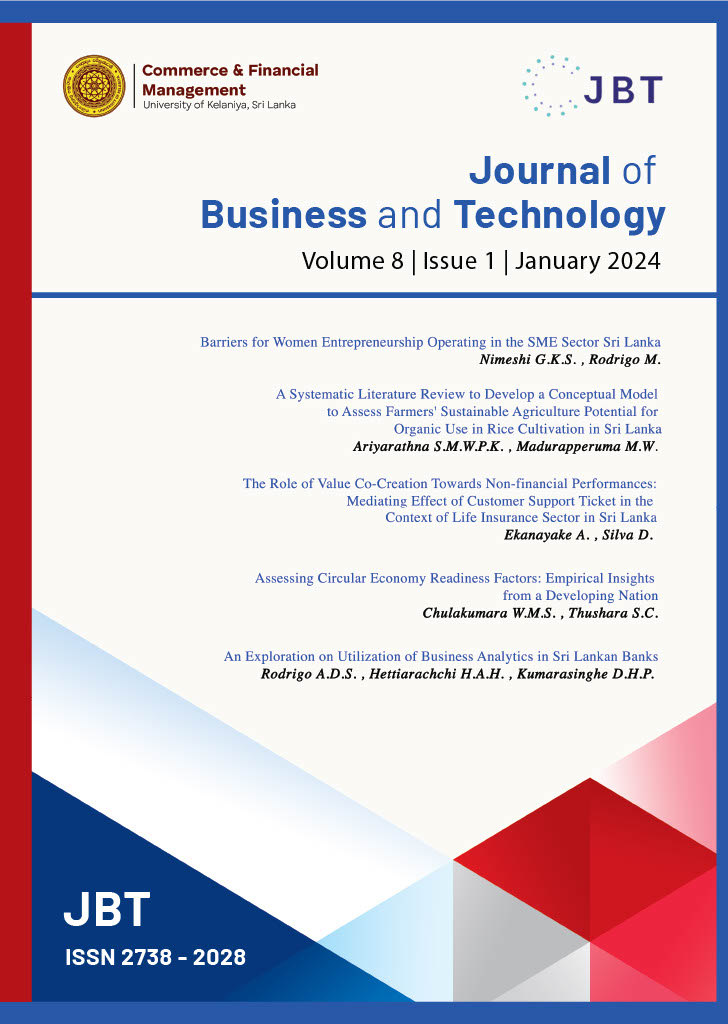
Journal of Business and Technology
Dr. Chathuri Senarath, Ph.D.
Department of Commerce and Financial Management

Editor-in-Chief
Dr. Chathuri Senarath
Department of Commerce and Financial Management
University of Kelaniya
Sri Lanka
Email: jbt@kln.ac.lk
Dr. Deepani Wijetunge
Department of Commerce and Financial Management
University of Kelaniya
Sri Lanka
Email: jbt@kln.ac.lk
Members
Professor Sisira Colombage
Associate Professor in Finance
Accounting & Finance, Economics and Law Federation Business School
Federation University Australia,
Melbourne, Australia
Email: sisira.colombage@federation.edu.au
Professor L.V.K. Jayathilake, Ph.D.
Department of Commerce and Financial Management
University of Kelaniya
Sri Lanka
Email: lakminij@kln.ac.lk
Professor M.J.M. Razi, Ph.D.
Department of Commerce and Financial Management
University of Kelaniya
Sri Lanka
Email: razim@kln.ac.lk
Dr. Shashika D. Rathnayake, Ph.D.
Department of Export Agriculture,
Faculty of Animal Science and Export Agriculture,
Uwa Wellassa University
Sri Lanka
Email: shashikadr@uwa.ac.lk
Dr. Pubuduni Jeewandarage, Ph.D.
Senior Lecturer
Department of Commerce and Financial Management
University of Kelaniya
Email: pubuduni@kln.ac.lk
Dr. Srinath Dissanayake, Ph.D.
Senior Lecturer
Department of Commerce and Financial Management
University of Kelaniya
Email: srinath@kln.ac.lk
Editorial Assistant
Ms. Sakunika Rathnayake
Lecturer (Probationary)
Department of Commerce and Financial Management
University of Kelaniya
Sri Lanka
Email: sakunika@kln.ac.lk
-
Desk-Review by the Editorial BoardAll the manuscripts submitted to the journal are, first, desk-reviewed by the editorial board to check the appropriateness and suitability of the manuscript to be published. Each manuscript will be reviewed by two members and if there is no one agreement, then the third member’s view will be considered. This will take maximum of three days.
-
Confirmation by the Editor-in-Chief (EIC)The EIC checks that the paper is appropriate for the journal and is sufficiently original and interesting followed by the Editorial Board members approval. If not, the paper may be rejected without being reviewed any further.
-
Nominating ReviewersThe editorial board and the Editor-in-Chief will nominate the appropriate reviewers to the manuscripts considering their field of research and expertise.
-
Invitation to ReviewersThe review invitation will be then sent to both reviewers along with the original manuscript and the review form. Reviewers may either accept or reject the invitation, but no rejection will be reported so far.
-
Reviewing the manuscriptUsually, two weeks of time will be initially granted for the review followed by weekly reminders either via emails or telephone calls. Maximum of one month will be provided for blind reviews. Reviewers are required to provide in detail and section-by-section evaluation on the manuscript using the given format. Reviewers will then submit their review reports to the Editor-in-Chief along with their recommendation to accept or reject the manuscript.If major problems are found at the first glance, the reviewer may feel comfortable rejecting the paper without further work.The reviewers’ comments will be sent to the authors soon after.
-
Acceptance Decision by the Editor-in-ChiefReviewers’ comments and recommendations will be finally evaluated by the Editor-in-Chief and accept accordingly. If the reviewers’ comments/recommendations differ significantly, then the manuscript will be sent a third reviewer. Final decision will be made following the 2/3 rule.
-
Acceptance Notification to AuthorsFinally, the Editor-in-Chief will send the Notification of Acceptance to the author/s along with the reviewers’ comments and other relevant documents, as provided by reviewers.
-
Revisions and Final SubmissionAuthors will be given maximum of two weeks to revise their original manuscripts as per the reviewers’ comments. For major revisions, it will be given maximum of one month and they will be re-evaluated by one of the reviewers to check whether the reviewers’ comments are properly addressed.
Submission
Formatting Guidelines
Author/s Name and Affiliation Name:
Name with Initial, Times New Roman, 11-point Affiliation: Department, Faculty, University/Institution, Country, Times New Roman, 10- point
Email: Times New Roman, 10
Should name the corresponding author
Manuscript Title: The title of the paper should be in 12-point Times New Roman font. It should be bold typed.
Abstract: Following the cover page, there should be an 'Abstract' page, which should contain the title of the paper, the subtitle 'Abstract' and a summary of the paper in single space, not exceeding 200 words in single column. The text of the paper should not start on this page, but on a fresh page with the title of the paper repeated.
Keywords: Abstract must be followed by a list of keywords, subject to a minimum of three. These should be arranged in alphabetical order and be separated by commas with a full stop at the end.
The body of Manuscript: Manuscript must be prepared on standard B5 size paper setting. It must be prepared on a single spacing and double column with a 1-inch margin set for top, bottom, left and right. It should be typed in 10-point Times New Roman font with page numbers at the bottom centre of every page.
Headings: All section headings should be in 11-point Times New Roman font, and sub-section headings should be in 11-point Times New Roman font. These must be bold-faced, aligned left and fully capitalized. Leave a blank line before each heading.
Table and Figure: Table and figure caption should be left aligned and numbered, 10-point. Source should be aligned left and below the table and figure, 10-point, italic. Do not use coloured tables or figures.
In-text Citations: Indicate the position of the reference in the text within brackets by the author's last name and the year of publication; e.g.: '(Rae 2007)' or incorporate it into a sentence, e.g.: 'as pointed out by Rae (2007)'.
References:References should be in the APA style.
Notes: Do not use footnotes. Minimize endnotes. If they are unavoidable, number them serially in the text using superscript and list them together on a separate sheet under the heading NOTES immediately following the text of the paper. Notes are not for citing a reference but for offering a significant explanation, which is important for understanding the text but is tangential to the main idea discussed therein.
Revised Manuscripts: At the end of the review process, the author is expected to incorporate the modifications suggested by the reviewers, if any, and submit a soft copy of the final revised manuscript.
